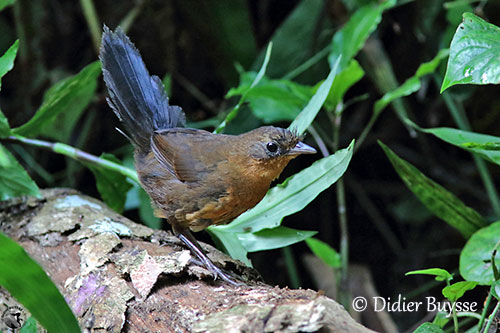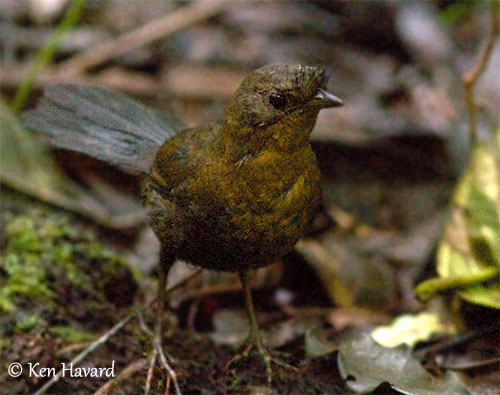
PROTECTION / THREATS / STATUS:
The Slaty Bristlefront has restricted range in which it is described as uncommon to locally fairly common, but it is more often heard than seen.
The species is threatened by habitat loss and degradation caused by deforestation for agriculture expansion, mining, urbanisation and road-building. The isolated forest remnants are threatened by clearance and fires spreading from adjacent cultivated areas.
However, the species is present in several protected areas throughout the range.
The size of the population is unknown but it is suspected to be declining.
The Slaty Bristlefront is not considered globally threatened at the moment, and the species is currently evaluated as Least Concern.
Fr: Mérulaxe noir
Ang: Slaty Bristlefront
All: Braunbauchtapaculo
Esp: Macuquiño Negro
Ita: Frontericcia ardesia
Nd: Borsteltapaculo
Sd: svart borstpanna
Photographers:
Didier Buysse
Vision d’Oiseaux
Ken Havard
My Bird Gallery & Flickr gallery 1 & Flickr gallery 2
Text by Nicole Bouglouan
Sources:
HANDBOOK OF THE BIRDS OF THE WORLD Vol 8 By Josep del Hoyo-Andrew Elliott-David Christie - Lynx Edicions - ISBN: 8487334504
BIRDS OF SOUTH AMERICA – Passerines - by Robert S. Ridgely and Guy Tudor – HELM Field Guides – ISBN: 9781408113424
The Birds of South America: Vol. II, The Suboscine Passerines De Robert S. Ridgely, Guy Tudor, William L. Brown, World Wildlife Fund – Editeur: University of Texas Press, 1989 – ISBN: 0292770634, 9780292770638 – 940 pages
Field Guide to the Songbirds of South America: The Passerines De Robert S. Ridgely, Guy Tudor – Editeur: University of Texas Press, 2009 – ISBN: 0292717482, 9780292717480 – 750 pages
Wildlife Conservation Society Birds of Brazil: The Atlantic Forest of ... De Robert S. Ridgely, John A. Gwynne, Guy Tudor, Martha Argel - Editeur: Cornell University Press, 2016 – ISBN: 1501704303, 9781501704307 – 432 pages
Cavity roosting in the Slaty Bristlefront Merulaxis ater (Rhinocryptidae)
Arthur Grosset's Birds (Arthur Grosset)
CREAGUS@Monterey Bay (Don Roberson)
Wikipedia, the free encyclopaedia


Slaty Bristlefront
Merulaxis ater
Passeriformes Order – Rhinocryptidae Family
INTRODUCTION:
The Slaty Bristlefront is endemic to SE Brazil where it is found in a fairly narrow strip of Atlantic Forest. It frequents humid lowland and montane forests, and usually remains on or very close to the ground.
This species shows a peculiar physical feature, a short crest of stiff, narrow feathers that stand erect at the base of the bill and forehead. These feathers are probably useful when the bird is foraging into the leaf litter.
An observation made in 2007 allowed to describe a roosting site placed in rock cavity and well-protected from the rain. This cavity was suspected to be also used as a nest-site.
The Slaty Bristlefront is very similar to the Stresemann’s Bristlefront (M. stresemanni) which is considered as nearly extinct. Although they could be conspecific, they are considered separate species. They differ in proportions of bill and feet, and general size.
The Slaty Bristlefront is threatened by habitat loss, but it occurs in several protected areas throughout the restricted range. It is described as uncommon to locally fairly common, and the population is declining. However, the species is not globally threatened at the moment.
DESCRIPTION OF THE BIRD:
Biometrics:
Length: 18-19 cm
Weight: M: 37 g – F: 33 g
The Slaty Bristlefront adult male has bluish-grey plumage almost overall, but lower back, secondaries, flanks and vent are dark rufescent brown, whereas the graduated tail is black with blue gloss.
The head is dark bluish-grey. We can see a short crest composed of stiff, narrow, elongated loral feathers standing upright at bill base and on forecrown.
The bill has black upper mandible and dark brown lower mandible with slightly paler base. The eyes are dark brown. Legs and feet are dark brownish-grey.

The adult female has uniformly brown upperparts. Chin, throat, breast and belly are cinnamon-rufous. Flanks and vent are dark olive-brown. The graduated tail is black with faint blue gloss.
On the head, we can see the stiff loral feathers at bill base. The lower mandible is mostly whitish with dark edge.

The immature resembles female with rufous-brown plumage overall. But more information about juveniles and immatures is required.
RANGE:
The Slaty Bristlefront is found in SE Brazil, from S Bahia (formerly) and Espírito Santo to E Paraná and E Santa Catarina.
This species occurs in a narrow band near the Atlantic coast, from Espírito Santo, S to Santa Catarina where it is mainly found in mountains, up to 1,800 metres of elevation.
HABITAT:
The Slaty Bristlefront is found in humid lowland and montane forests, and mature secondary woodland. It is visible locally down to 100 metres, but more generally between 400 and 1,800 metres of elevation.

CALLS AND SONGS: SOUNDS BY XENO-CANTO
The Slaty Bristlefront is known for its enchanting song described as a cascading series of beautiful musical notes, first very loud and then tumbling downwards before to become softer towards the end.
While feeding, the birds give an odd metallic “tink” call. The alarm call is a loud “tsewk-tsewk, pit”. We can also hear a squealing “keekick” and a faint, brief laughing “he-he-heeheeheehee”.
BEHAVIOUR IN THE WILD:
The Slaty Bristlefront is more terrestrial than other Rhinocryptidae species. Some observations describe the bird on the ground, digging with the head into the leaf litter. While foraging in this way, the vision is probably aided by the long loral feathers.
This species is usually seen alone, walking or running on the ground, sometimes hopping up into low, tangled vegetation or onto logs. The long, graduated tail is often slightly spread.
The diet of the Slaty Bristlefront is poorly known, but the foraging behaviour may indicate a diet composed of various arthropods, probably mainly terrestrial species.
The Slaty Bristlefront is suspected to roost in cavities outside breeding season. Both male and female were observed entering a rock cavity, well-protected from rain. The floor of the rock crevice was covered by leaves and other plant material probably used as nest material during the breeding period. But more study is required.
The Slaty Bristlefront is presumed sedentary within its restricted range.
These birds are mostly ground-dwelling species with skulking behaviour, and their flight capacity is very limited. The wings are short and rounded, making the birds incapable of sustained flight. However, they have strong feet and rather large claws, well-adapted to their terrestrial behaviour.
REPRODUCTION OF THIS SPECIES:
The Slaty Bristlefront male sings mainly between October and February, although in São Paulo, it is also heard in July and September.
This species produces a single brood per season. The breeding behaviour is unknown, but the Rhinocryptidae are usually strongly territorial and some fights may occur against intruders and neighbours.
From an observation at Intervales State Park (Ribeirão Grande, São Paulo) in SE Brazil in June 2007, this species is suspected to nest in rock cavity or rocky fissure. This observation was made at Gruta Colorida, a deep gully with a limestone outcrop with a cave and numerous rock cavities on the rock face.
Male and female used a hole as roosting site, but the floor was lined with leaves and other plant material, indicating that this place was possibly also used as nest-site. The cavity was about 12 x 24 centimetres at the entrance, and 1,45 metres above the ground. It was well-protected from the rain.
Several species of this family are known to nest in cavities, but here, the hole is used both for roosting and nesting. No more information.
